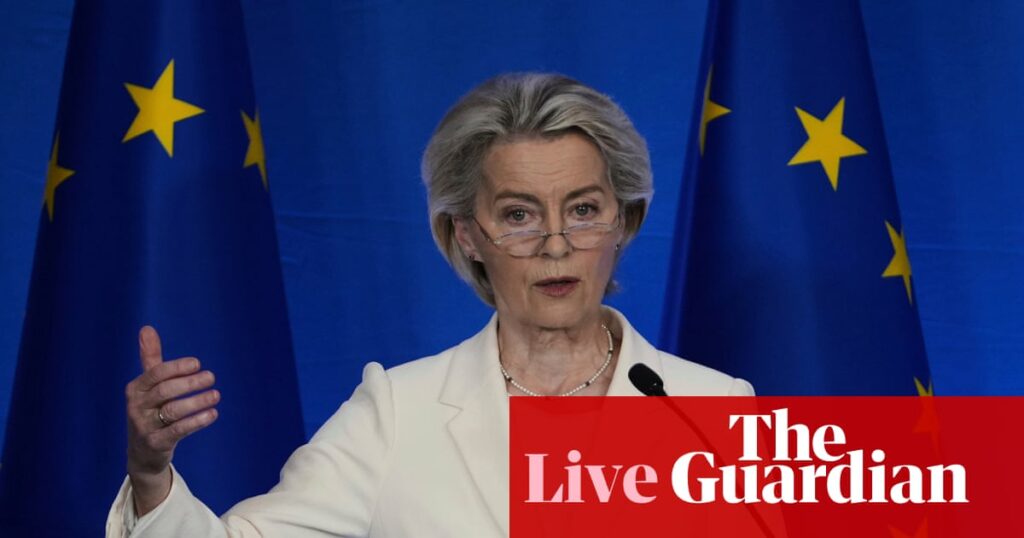
European Commission President Ursula von der Leyen is set to meet U.S. President Donald Trump in Scotland this Sunday to discuss the future of transatlantic trade relations. This meeting, confirmed by von der Leyen following what she described as a “good call” with Trump, comes amid speculation that a significant trade agreement between the European Union and the United States is imminent.
The announcement follows reports from EU diplomats indicating that the deal is nearly finalized and awaiting Trump’s approval. The meeting, which takes place during Trump’s four-day visit to Scotland, is seen as a potential precursor to a formal announcement, assuming no last-minute complications arise. Trump, who is known for his unpredictable negotiation tactics, described the chances of reaching a deal as “50:50” before his departure, adding an element of suspense to the weekend’s events.
Trade Tensions and Economic Implications
The potential trade agreement could ease tensions that have been mounting due to U.S. tariffs on EU exports. Currently, the EU faces tariffs on over 70% of its exports to the U.S., including a 50% tariff on steel and aluminum, a 25% levy on cars and car parts, and a 10% tariff on other goods. Trump has threatened to increase these tariffs to 30% by August 1 if no deal is reached, a move that EU officials warn could devastate transatlantic commerce.
Volkswagen, Europe’s largest car manufacturer, has already reported a €1.3 billion hit due to these tariffs in the first half of the year. The American Chamber of Commerce in Brussels has cautioned that ongoing trade conflicts could jeopardize $9.5 trillion in business, highlighting the high stakes of the negotiations.
Market Reactions and Economic Forecasts
Meanwhile, European markets have reacted cautiously to the developments. The pan-European STOXX 600 index closed 0.2% lower on Friday, reflecting investor uncertainty. However, sectors heavily impacted by tariffs, such as luxury goods and automotive, saw gains, with companies like LVMH and Volkswagen experiencing a rise in stock value.
“It’s hard to spin it as a good deal, but it would at least avoid much higher U.S. tariffs and retaliation from the EU,” said Jack Allen-Reynolds, deputy chief euro zone economist at Capital Economics.
Analysts suggest that a successful trade deal could remove a significant downside risk for the EU economy, potentially reducing the need for further interest rate cuts.
Political Maneuvering and Strategic Interests
The meeting between von der Leyen and Trump is part of a broader political choreography, with Trump also scheduled to meet British Prime Minister Keir Starmer. The U.S. President has praised Starmer, describing him as a “good guy” and hinting at further discussions on the U.S.-UK trade deal. Trump’s visit to Scotland, where his mother was born, also includes a private visit to his golf courses, adding a personal dimension to the diplomatic engagements.
In addition to the EU negotiations, Trump has been vocal about his broader trade strategy, which includes sending tariff letters to various countries. He has indicated that most deals are nearing completion, with tariffs ranging from 10% to 50%, depending on the country.
Looking Ahead: The Road to a Deal
As von der Leyen prepares to meet Trump, the EU remains hopeful that a deal can be finalized over the weekend. However, the outcome hinges on Trump’s willingness to compromise and the EU’s ability to meet his demands. The potential agreement would likely include a 15% baseline tariff on EU goods entering the U.S., with higher tariffs on steel and aluminum.
With the August 1 deadline looming, the coming days will be crucial for both sides. A successful deal could avert a trade war and stabilize the transatlantic economic relationship, while failure to reach an agreement could lead to increased tariffs and further economic strain.
As the world watches, the meeting in Scotland could mark a pivotal moment in EU-U.S. relations, shaping the future of global trade dynamics.





